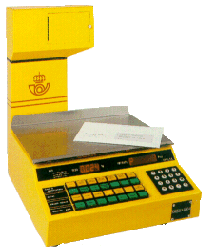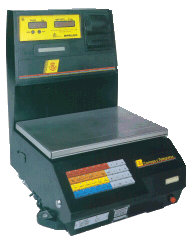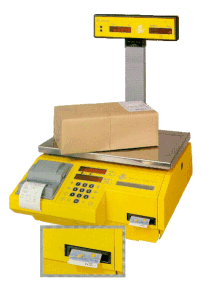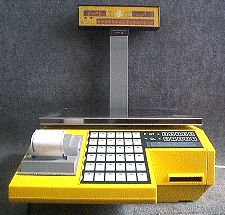| The
EPELSA
franking scales and vending machines |
The Organismo Autonomo de Correos
y Telecomunicaciones (O.A.C.T.) of Spain with
the intention of obtaining greater flexibility when franking mail in the
Post Offices, decided to use machines capable of charging according to
the weight, with a simple sequence of key presses.
The Spanish company EPELSA
developed an easy to use franking balance which is to be found in
all the Spanish Post offices.
The most important characteristics
of these balances are :
-
Triple security system in the storage
of the printed values.
-
Issuing variable value stamps
or self adhesive thermal ATMs with both
a franked value and identification of the machine and town.
-
Issue of a purchase receipt to the client.
-
Display client and user.
-
A keyboard with a luminous indication
of key pressed organized according to type of correspondence, destination,
weights and all other relevant factors.
-
Printing of data of printed values classified
by type of correspondence.
-
An RS-232 interface that allows
external equipment to do the following functions :
-
Programming of tariffs according to
the correspondence type, destination, after allowing for the different
weights ...
-
Access to the totals issued by the balance.
-
Access to the balance peripherals ;
Display, printer and label printer.
-
User friendliness.
Thanks to the characteristics of these
machines there has been a remarkable improvement in the process of franking
in the Post offices : Errors in the franking are avoided, integration of
the balance into the general computerized system, easy identification of
the postal window, easy in updating the postal tariff changes, reduction
of queue sizes, exactitude between the weight and the tariff and the possibility
of issuing of stamps repetetively.
| 2.
The models of postal scales |
 |
This
was the first balance manufactured by Epelsa to be used in Correos
(The Spanish Postal Service).
In
1981
Correos
bought 325 of this model.
The franking
cost was calculated by the machine according to the weight, destination,
type of sending and postal tariffs. The balance could print receipts but
not stamps (but not ATMs, see image) ; The stamps were printed using
a external dot matrix printer connected to the balance.

In the middle
90's they were replaced by the new Epelsa ET-CB.
The model Epelsa BF-10C or
Correos
Comercial appeared some months later. This was a balance only able
to calculate and show the cost of the franking according to the
weight, destination and type of sending. The machine did not print receipts
nor use the printer equipment of stamps.
This machine could be useful not
only in Correos, but in other companies which wanted to calculate
the postal cost of the sending. |
 |
|
|
The
Epelsa
ET-CB model was the first balance which incorporated stamps
or
ATM printer - the first franking balance. It was installed
from 1992 with a total of 1778 units in service. They are
recognized easily by its black body and serial numbers from 0001.
 |
A keyboard
that can charge automatically or can be equipped with a keyboard inhibitor
that allows its use with a computer system.
The balance printed thermal
variable
value stamps or ATMs with 4
digits, resolution of 4 dots/mm (100
dpi).
They were used
until December 2001 (after which the Euro was used) and the 1668
balances still in use were replaced by the model Epelsa
RL/T. |
|
|
 |
The
model
ET-RL is the commonest in the Post offices, with 4070 balances
installed and 150 more on public tender (April
2002), and serial numbers from 3000 (3000,
4000, 5000, 6000 and 7000).
They have a yellow colour body and,
at the request of the O.A.C.T.
are linked to a computer system of mail processing called IRIS (Version
4.01).
With the increase of the postal tariffs
and the possibility of values greater than 9.999 pts being needed, these
machines allowed the thermal printing of stamps or ATMs
with franking value of 5 or 6 digits.
This is a double possibility that all the machines
have, being one
of the options that could be selected at the moment of their installation
and programming. |
|
|
Two series, practically identical
had been manufactured (referring to itsí appearance) ;
-
The first one (ET-RLa)
with metallic body incorporates a printing mall pillow of lower
resolution (4 dots/mm - 100 dpi)
and,
therefore, the franking balances of this series print the ATMs
with the printing varieties called
"wide
or large". There are around 500 units, with serial numbers
from 3000.
-
The second series (ET-RLb)
with plastic or ABS body is more recent and incorporates a mall
pillow of much greater resolution (8 dots/mm
- 200 dpi), and the balances print the printing
varieties called "small or narrow".
SPAIN.
Post Office equipped with franking balances Epelsa ET-RL,
are connected to the computer system IRIS.
The equipment
consists of the franking balance (weigh,
issue ATMs and receipts), the computer and the printer for documents. |
 |
|
|
From
August
2001 and until December many important modifications were made
in the computer system IRIS and in the EPROM
memory of all the balances to adapt them to the new Euro currency
making it possible to use the new currency when the Postal Authorities
decided to do so. This adaptation affected the graphic printed on the ATMs,
the receipts and all the process of security and account in the franking
balances.
The
Spanish
Post started to use the Euro in Post Offices between the 22
and 28 of December 2001.
More information
about types and varieties printing ...
 |
In
2001
Correos
arranged with Epelsa to replace all the old balances
Mobba
and Epelsa ET-CB with a new model of franking
balance, the
RL/T.
This new equipment
can only work in Euros ( € ) and allowed postal employees work
only to work it using the keyboard to print ATMs or working with
a keyboard inhibitor through the IRIS computer system which allows
ATM printing and other postal services (postal giros, telegrams,
track & trace, ...). |
|
|
The first series
of Epelsa RLT franking balances (with serial numbers from 0001)
arrived at the post offices in Spain and Andorra in the
last weeks of 2001 but they weren't put into service officially until
January 2nd, 2002.
In
April
2002 there were 1271 Epelsa ET-RLT franking balances in service.
(Note that
these new balances have the same serial numbers that the old type
ET-CB,
and that can cause confusion).
At
collecting
levels these new balances have a thermal printing head with high resolution
(8 dots/mm - 200 dpi) identical to the one in the balances
ET-RLb
(2nd series); it doesn't really mean a new printing
variety.
This model
ET-RLT,
also know as RL-POSTAL, allow its use by postal services in other
countries, with just a very simple modification of the keyboard and the
postal tariffs. This model has been installed, for example, in Costa
Rica post offices, but personalized with its own colours and post
logo.
The manufacturers :Epelsa
-
Frama - Klüssendorf
- Mobba
See also : The
EPELSA LF vending machines
ATM
Web - Spain and Latin American Postal Services: http://www.ateeme.net
©
J. Jove - M. Sans.
ATEEME. Variable value stamps study group
All
rights reserved. This page was created in 2000. Last updated : 08.01.04.
English edition rewritted by S. Goodman
|








